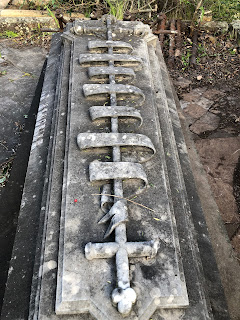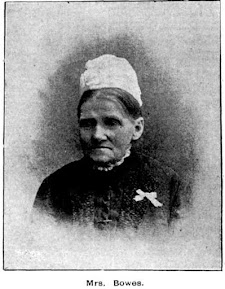Beauty in Stone (or cast iron!)
Welcome to 2023 and I'm happy to have you along with me on a journey through Rookwood. I have a number of stories to share as the year progresses.
For this post I am veering in a slightly different direction.
During Victorian and Edwardian times in particular, stonemasons issued books that detailed the various types of headstones that could be made and purchased, a bit of a production line of design. We see many similar headstones throughout cemeteries of this time and this practice still continues.
Wandering around the older parts of Rookwood, there are many examples of very unique and beautifully carved headstones and monuments, and it is a few of these that I want to share with you today.
JOHN WILLIAM WOOD
John William was born in 1811, the son of John Wood, tailor, and his wife Elizabeth. John senior was convicted of forgery and uttering and was sentenced for life, arriving here in 1813. He received a pardon in 1847 whilst residing in Parramatta and conducted a successful tailor/draper business in Sydney. John Senior died in Tasmania in 1858. In 1831, as a 20-year-old, John William Wood inherited five acres in the Glebe area. In 1837 he built a 10 room "Gentleman's residence" almost certainly designed by John Verge and named it "Glenwood".
John William was a trustee and financial supporter of St John's Glebe and leased the home after his mother's death in 1872, sailing to England where he died in 1875 in Great Portman Square London. One of his major benefactors after his death was The Blind Society.
John William Wood, Esquire, is buried under a heavy stone slab with an exquisitely carved beribboned sword. His mother, Elizabeth, is remembered on his grave.
John William Wood - photograph authors own
GEORGE SUTHERLAND CAIRD
George was born in 1829 at Greenock, Scotland, the fourth son of John Caird, partner and manager of the engineering firm of Caird & Co., and his wife Janet. After attending the University of Edinburgh George arrived in Sydney in 1856 and found the mercantile firm of Caird, Paterson & Co., which during the booming time soon expanded. In later years he took up an interest in mining and with others developed the Chillagoe area in Queensland.
One of a family of academics, George fostered higher learning and donated sums to the University of Sydney for a scholarship in chemistry. Further benefactions were made by his daughter and legacies are still active.
George's wife, Elizabeth Richardson, was the youngest daughter of Thomas Raine. His success in the merchant marines, mastering a ship after a typhus epidemic and whilst the sole survivor examining parts of the Great Barrier Reef was greatly admired. Raine Passage and Raine Island were named after him. He was promoted to Captain and made many voyages to Australia, some with convicts and his humane treatment of them earned him the commendation of Governor Lachlan Macquarie, who he had the privilege of returning to England in 1822.
George Caird died at his residence in Woollahra in 1901 after suffering from influenza. He lies under a simple and elegant raised stone with a large cross. His wife who predeceased him in 1875 and three of their children join him in the plot.
George Sutherland Caird - photographs authors own
CHARLOTTE JANE ROWE
Charlotte was born in Sydney in 1838, one of nine children to William Piper and Sarah Matilda Neale. Her father had arrived in the colony in 1801 on the Minerva, a convict ship that transported his father, Francis for stealing flax from a barge in the river Thames accompanied by Sarah, his wife, William's mother.
Charlotte's mother Sarah Neale was the daughter of William Neale who served in the 2nd Regiment prior to 1793. Sarah's brother, John's, two sons James and Thomas did well in business, and it is believed that through these men, Charlotte's cousins, that she met influential people.
Charlotte married well.
Her husband was a Cornish man, born in 1829, by the name of Thomas Rowe. Thomas entered his father's building business as a draughtsman. He arrived in Sydney in 1848 and worked for local builders until 1851 when he went to the Sofala goldfields. In 1853 he set up a building business with his brother in Pitt Street Sydney and from 1857 he practiced as an architect. Rowe became very successful and extended his practice to become on the largest in NSW.
His landmark buildings during the time of his life with Charlotte included the Presbyterian Church in Bathurst, The Jewish Synagogue in Elizabeth Street Sydney and the Sydney Hospital in Macquarie Street amongst others. In 1871 he was the founder of the Institute of Architects of NSW and served several times as its President.
Charlotte married Thomas at the age of 18 in 1857 and gave birth to six children, three of whom died in infancy, before succumbing to her fate on 19 March 1877 at the age of 38.
She and her infant children, Ida, Lillian and Lily, rest below a large, beautifully carved and unique monument.
(There is so much more to disclose about the Neale family' - for a future blog).
Charlotte Rowe - photograph authors own
JOHN ROBERT BUBB
John Robert was born in 1832 in Gloucester, England the son of Robert Bubb and his wife Heleh. John and his parents with two older siblings arrived in Sydney in 1839 as bounty passengers. Robert Bubb was listed as a French Polisher. Helah died in 1852 and Robert was listed at the time as an iron founder. He remarried in 1856 to Amelia Old, the daughter of a brass founder.
One of Bubb's greatest legacies, besides, the numerous amounts of iron lacework on many Victorian homes, were the red post boxes designed by T Levinge of the NSW Postmasters General Department. Based on a Belgian design the boxes were circular with a Crown mounted upon the dome; the Crown being supported by acanthus leaves. There were slight variations on Levinge's design, most notably the ones that had the posting slot so positioned in order that a person on horseback did not have to dismount to post a letter!
John Robert followed in the footsteps of his father and took over the running of the iron foundry which had relocated from Victoria Place in the Pyrmont area to George Street Sydney in 1867. He in turn passed on the company to his son Alfred Ernest Bubb and his nephew Joshua Tinson Bubb in 1885. When Robert Bubb died of stomach cancer in 1891 he left a thriving business.
Cast iron became batter manufactured over the years and was often used for signage and for monuments and footings in cemeteries; easily packed down and transported by rail to regional areas.
John Robert built a grand home in the Burwood area named Tulloona to house his large brood and was active in the proclamation making Burwood a municipality. Many of the streets in the Burwood area are named after his children.
John Robert died in February 1900 and was buried in the Independent area of the Cemetery. His monument is one manufactured from the Foundry, including the fence and footings and is the only one in the Cemetery of this kind.
Robert John Bubb - photograph author's own
Close up of Robert John Bubb's monument - photograph author's own
This blog today represents just four of the unique headstones and/or monuments to be found in The Necropolis. Unfortunately, the stonemasons who created the first three pieces of art are unknown to me.
It's always a great pastime to seek out the unique ones and I will publish another blog in the future of this nature.
If you have any comments, please do so here for at the Facebook page under
rookwoodcemeterydiscoveries
or send me a personal email at
lorainepunch@gmail.com








Comments
Post a Comment